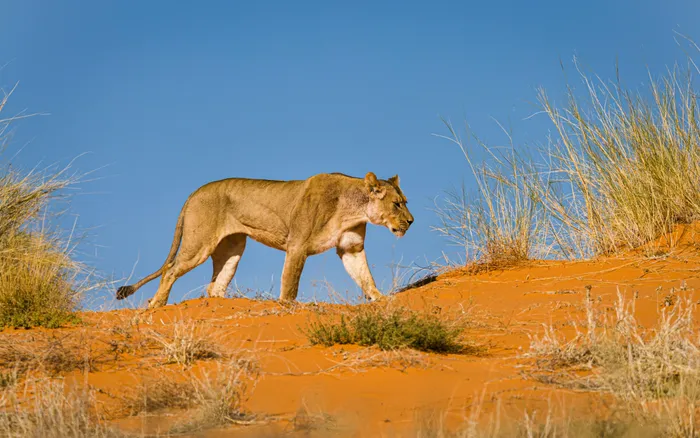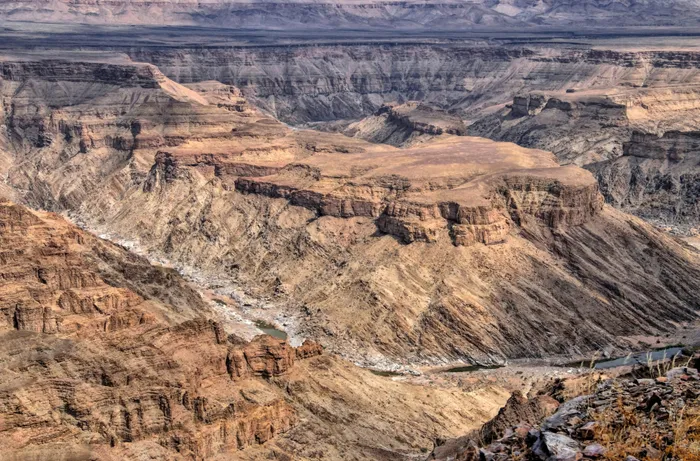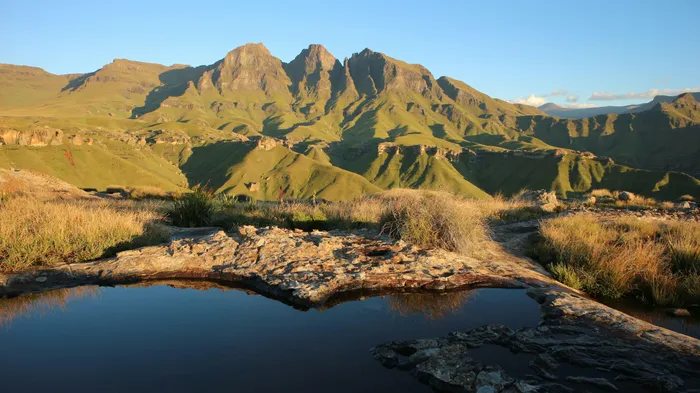Adventure awaits: why Gen Z is trading cities for Africa's Transfrontier Conservation Areas
TRAVEL INSPIRATION

In the Kgalagadi Transfrontier Park, a Kgalagadi lion walks on a red-sand dune.
Image: Unsplash
As the world emerges from the restrictions of the pandemic, the travel landscape is evolving, particularly for Generation Z, a demographic known for its disregard for traditional itineraries and iconic landmarks.
Instead, these intrepid explorers seek out distinct and immersive experiences, often travelling beyond the beaten path to discover the hidden gems of our planet.
Their new travel ethos, focused on authenticity, well-being, and a sustainable approach to tourism, places destinations that foster such principles at the forefront of their preferences.
As this wave of new adventurers rises, Africa stands poised to become their playground, thanks to its unique Transfrontier Conservation Areas (TFCAs).
For many Gen Z travellers, ticking off bucket-list destinations has become passé.
Instead, they lean towards multi-destination trips, coupling nature-based activities with wellness retreats, and prioritising cross-border exploration that allows them to engage with diverse cultures and ecosystems.
TFCAs - regions that transcend international boundaries and are established to preserve wildlife and promote sustainable tourism - serve as the perfect canvas for the enriching travel experiences this generation craves.
Africa’s TFCAs offer a wealth of scenic landscapes, abundant wildlife, and cross-border mobility, making them an ideal backdrop for today’s travel-savvy youth.
Here are some of the continent’s standout TFCAs that appeal to Gen Z's innate desire for adventure, sustainability, and holistic experiences.

Victoria Falls is situated on the border between Zimbabwe and Zambia and is part of the Kavango Zambezi Transfrontier Conservation Area (KAZA).
Image: Unsplash
Kavango Zambezi Transfrontier Conservation Area (KAZA)
Spanning an area larger than Germany and Austria combined, the Kavango Zambezi Transfrontier Conservation Area (KAZA) is a magnificent natural mosaic that lies at the confluence of Angola, Botswana, Namibia, Zambia, and Zimbabwe.
It encompasses diverse ecosystems, including the breathtaking Okavango Delta - a UNESCO World Heritage site - and the thunderous Victoria Falls, one of the Seven Natural Wonders of the World.
The contrasts in KAZA range from thick woodland to sprawling savanna, offering a rich tapestry of experiences.
The Delta pulsates with life, while the Falls roar majestically; together, they provide the perfect backdrop for both exhilarating activities and peaceful retreats.
Outdoor lovers can embark on guided canoe trips through the Delta, join walking safaris, or simply unwind amidst the nature that flourishes in this sprawling region.
Great Limpopo Transfrontier Park
The Great Limpopo Transfrontier Park, formed by merging Kruger National Park in South Africa with Gonarezhou National Park in Zimbabwe and Limpopo National Park in Mozambique, represents a vast expanse of wilderness that invites Gen Z adventurers to immerse themselves in nature.
Here, wildlife abounds - from majestic elephants and elusive leopards to numerous antelope species vital to local ecosystems.
Visitors can engage in thrilling game drives, hike through diverse landscapes, or enjoy canoeing along the rivers, combining wildlife observation with cultural experiences through local festivals and traditional craftsmanship.
The park's commitment to conservation and community engagement makes it an ideal destination for those looking to connect with nature while supporting sustainable practices.

An aerial perspective of Namibia's Fish River Canyon, which is part of the |Ai-|Ais/Richtersveld Transfrontier Park.
Image: Unsplash
Ai-Ais/Richtersveld Transfrontier Park
Situated at the border of South Africa and Namibia, the Ai-Ais/Richtersveld Transfrontier Park showcases the dramatic meeting of mountains and desert.
It is a land of stark beauty that challenges conventional notions of a safari, revealing a haven for succulent plants and unique fauna that thrive in arid conditions.
The open skies invite stargazing, while local Nama communities share their ancient traditions and connection to the land with visitors.
With adaptable wildlife and opportunities for relaxation at the Ai-Ais Hot Springs Resort, this park offers Gen Z travellers an authentic interaction with nature and culture.
The blend of adventure and relaxation makes it a perfect getaway for those seeking both thrill and tranquillity.
Kgalagadi Transfrontier Park
For adventurers yearning for an unforgettable desert safari experience, the Kgalagadi Transfrontier Park is a must-visit.
Formed from the amalgamation of South Africa's Kalahari Gemsbok National Park and Botswana's Gemsbok National Park, this park is renowned for its iconic black-maned Kalahari lions and awe-inspiring landscapes dominated by rolling red dunes.
With an unfenced boundary allowing wildlife to roam freely, Kgalagadi provides unique opportunities for both vehicle-based and walking safaris.
Whether capturing breathtaking nature portraits or witnessing the stark beauty of the desert, this park promises an authentic safari experience like no other.
The park's remote location also offers a chance for digital detox, allowing travellers to disconnect from technology and reconnect with nature.

The Drakensberg/Maloti Mountains shared between Lesotho and South Africa.
Image: Unsplash
Maloti/Drakensberg Transfrontier Project
Nestled between Lesotho and South Africa, the Maloti-Drakensberg Transfrontier Project offers a rich blend of natural beauty and cultural heritage.
With its majestic mountains, diverse ecosystems, and 3 000-year-old rock art, the area invites exploration and motivation for outdoor activities ranging from hiking to mountain biking.
Efforts here focus not only on the preservation of biodiversity but also on improving livelihoods through sustainable tourism and community engagement.
Visitors can connect with the local heritage while contributing to conservation efforts that benefit present and future generations.
This project exemplifies how tourism can be a force for good, fostering both environmental stewardship and cultural appreciation.
The allure of TFCAs for Generation Z
For Gen Z travellers, the allure of TFCAs lies in their potential for multi-destination journeys that promise immersive and transformative experiences.
By prioritising unique, well-being-focused adventures and supporting sustainable tourism practices, this travel-first generation is redefining the way we explore the world.
They seek out destinations that not only offer adventure but also align with their values of sustainability and authenticity.
As Africa opens its arms to welcome this eager cohort of explorers, there’s no better time to embark on an adventure through its enchanting transfrontier conservation areas.
Whether it’s the thrill of spotting wildlife in their natural habitats, engaging with local cultures, or simply enjoying the breathtaking landscapes, TFCAs provide a wealth of opportunities for unforgettable experiences.
In conclusion, Africa's Transfrontier Conservation Areas are not just destinations; they are gateways to a new way of experiencing travel.
For Generation Z, these areas represent a shift towards more meaningful, sustainable, and adventurous journeys that resonate with their values and aspirations.
As they set out to explore the wonders of Africa, they are not only discovering the continent's beauty but also contributing to its preservation for future generations.